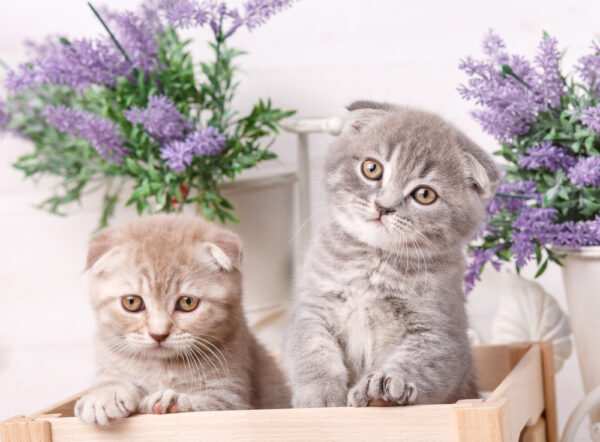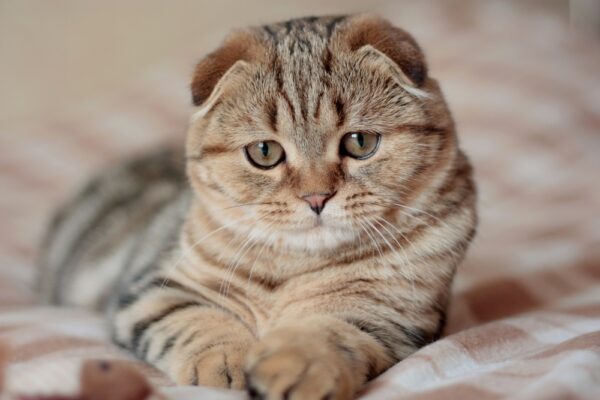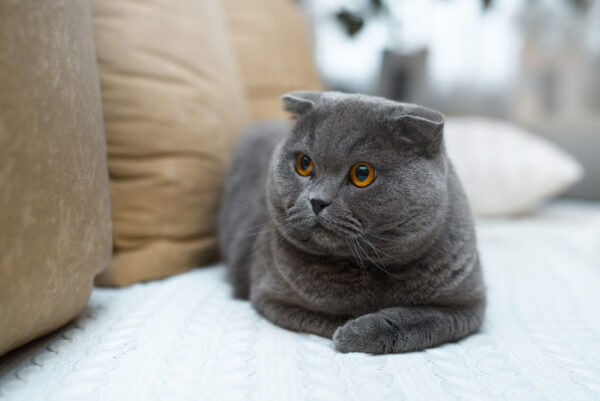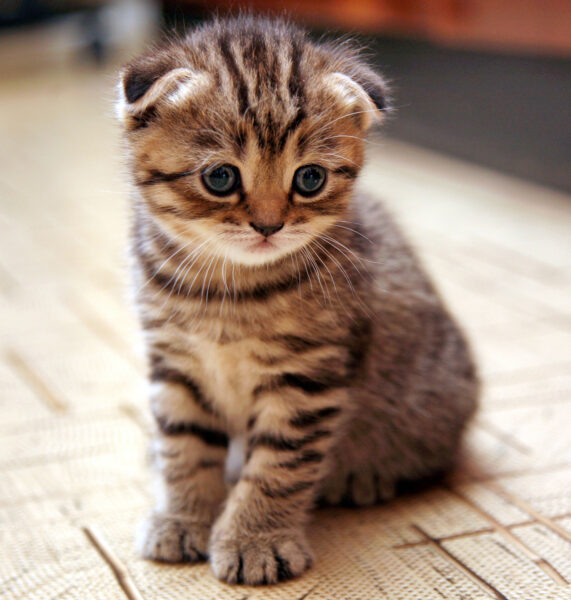
The Scottish Fold Cat: Distinctive and Cherished Cat
Scottish Fold Cats are a distinctive and cherished breed known for its iconic folded ears and placid disposition. Originally discovered in Scotland, this breed emerged from a natural genetic mutation. The folded ear trait that defines the breed is due to a mutation in the cartilage, which gives the Scottish Fold cats its unique owl-like appearance. These cats come in both short and long-haired varieties and exhibit a range of colors and patterns. They are recognized for their medium-size build and rounded features that extend from their face and eyes to their body and tail.
Closely bonded with their human families, Scottish Folds are known for being very affectionate and loyal. They tend to have a calm and gentle temperament, which makes them a good companion for both individuals and families. Prospective owners should be aware of the specific health challenges associated with the breed, primarily concerning the genetic mutation that affects their cartilage. This can lead to issues such as osteochondrodysplasia, a condition that affects their bones and joints. Regular veterinary check-ups, a healthy diet, and proper care can help manage and prevent potential health problems.
Key Takeaways
- Scottish Fold Cats are recognized by their unique folded ears and rounded physique.
- They are family-oriented felines with a gentle and affectionate nature.
- It’s essential to monitor their health closely due to breed-specific genetic conditions.
Origin and History

The Scottish Fold is a distinctive cat breed with an intriguing genesis in Scotland. This breed is uniquely characterized by its folded ears, which are the result of a genetic mutation. The story of the Scottish Fold begins in 1961 with a white barn cat named Susie. She was discovered on a farm near Coupar Angus in Perthshire, where her folded ears caught the eye of cat enthusiasts.
Susie’s unique ears were caused by a dominant gene mutation affecting the cartilage, resulting in an endearing folded appearance. This trait, which resembles that of an owl, quickly garnered interest. When Susie had kittens, some inherited her folded ears, confirming the trait’s hereditary nature.
A neighboring farmer and cat fancier, William Ross, took notice of Susie’s kittens and acquired one, seeking to develop a new breed. Ross worked with geneticist Pat Turner, and together they initiated a breeding program. Their efforts established the folded ear trait in subsequent litters, marking the foundation of the Scottish Fold breed.
The name “Scottish Fold” reflects both the breed’s country of origin and its distinguishing folded ears. Despite the charm of the fold, not every Scottish Fold inherits the feature as kittens may be born with either straight or folded ears.
| Key Entities | Relevance in Origin |
|---|---|
| Scottish Fold | Cat breed distinguished by folded ears. |
| Scotland | Country where the breed originated. |
| Susie | The foundation cat of the Scottish Fold breed. |
| Mutation | Genetic anomaly causing the ear fold. |
| Dominant Gene | Responsible for the transmission of the folded ear trait. |
| William Ross | Cat enthusiast who initiated the breeding of Scottish Folds. |
The Scottish Fold cats’ noteworthy origin is a testament to the fascinating results of genetic variation, coupled with dedicated breeding efforts, which led to the beloved breed known today.
Scottish Fold Cat Physical Characteristics

The Scottish Fold cat is distinguished by its unique lop-eared appearance, robust body, and varying coat lengths. These features, combined with the breed’s round faces, impart a distinct look that sets them apart from other feline breeds.
Distinctive Ears
Scottish Fold cats are recognized primarily for their folded ears, a characteristic resulting from a natural genetic mutation. The ears fold forward and downward, granting the breed its namesake. Not all Scottish Folds have the folded ears; some may retain straight ears. Those with folded ears can vary, with the degree of the fold ranging from a single fold, slightly bending forward, to a double or even a triple fold, giving the ear a tighter curl.
Body Appearance
The body of a Scottish Fold cat is typically medium in size, with males usually ranging between 9 to 13 pounds and females somewhat smaller, generally weighing 6 to 9 pounds. They possess a well-rounded body structure, with a padded look and robust bone structure. The breed’s face is also round, complementing the folded ears. Attention should be given to the tail, which should be flexible, as \textit{stiffness} can suggest potential issues.
Coat Varieties
Scottish Fold cats come in two main coat types: short-haired and long-haired, with the latter often referred to as the Highland Fold. Short-haired Scottish Folds have dense and plush coats, where the hair stands away from the body, while long-haired varieties boast a full coat complete with toe tufts, a ruff, britches, ear furnishings, and a pronounced tail plume. Regardless of the length, the coat may come in various colors and patterns.
Behavior and Temperament
The behavior and temperament of Scottish Fold cats are characterized by their affectionate nature and gentle demeanor. They exhibit a calm and friendly disposition, making them well-suited for various household environments.
Personality Traits
Scottish Fold cats are known for their sweet personalities and tend to form strong bonds with their caregivers. They are affectionate and often seek the love and attention of their human family. These cats are typically not vocal and have a quiet nature, though they will communicate their needs when necessary. Their temperament is largely calm, making them suitable companions for individuals or families.
- Affection: Highly affectionate and social
- Vocalization: More quiet than vocal
- Behavior: Calm, adjusting well to family life
Activity and Playfulness
While Scottish Folds enjoy periods of relaxation, they are also playful and intelligent. They appreciate interactive play and activities that stimulate their minds. Toys and puzzles are particularly effective in engaging their playfulness and catering to their intelligent nature.
- Activity Level: Moderately active with a playful demeanor
- Playfulness: Enjoys interactive play and mental stimulation
- Social Interaction: Friendly and enjoys the company of humans and pets alike
Health and Lifespan

When considering the Scottish Fold cat breed, one must be aware of their peculiar genetic structure causing the characteristic ear fold but also predisposing them to various health issues. Lifespan can be influenced by the breed’s genetic concerns and the overall health management, including diet and exercise routines.
Genetic Health Concerns
The Scottish Fold breed is susceptible to a genetic condition known as osteochondrodysplasia, which affects cartilage and bone development. This condition is directly related to the gene that causes the fold in their ears. It can lead to painful arthritis and mobility issues. Regarding genetic diseases, polycystic kidney disease (PKD) is another concern that may affect some Scottish Folds, characterized by the formation of cysts in the kidneys which can eventually lead to kidney failure.
Common Health Issues
Although not limited to this breed, Scottish Folds may also develop cardiomyopathy, a serious heart condition, which requires vigilant monitoring. Maintenance of ear health is particularly important as the folded nature of their ears can predispose them to ear infections. Proper nutrition and regular exercise are key to managing the breed’s health, as obesity can exacerbate joint problems and lead to a life filled with pain. With attentive care, a Scottish Fold can enjoy a lifespan that averages around 15 years, although this can vary depending on individual health and breeding practices.
Care and Grooming
Proper care and grooming are essential for the health and happiness of a Scottish Fold cat. This section will guide owners on how to manage their cat’s diet, ensure adequate exercise, and maintain their distinct grooming needs.
Diet and Nutrition
Scottish Folds require a balanced diet rich in nutrients. Feeding them high-quality commercial cat food that meets the AAFCO (Association of American Feed Control Officials) guidelines is usually recommended. It’s vital to monitor their food intake as this breed can be prone to obesity, which can exacerbate potential hereditary health issues such as cardiomyopathy. Owners should also ensure fresh water is always available.
- Recommended Food Types:
- Dry Food: Helps keep teeth clean
- Wet Food: Provides hydration
Exercise
Regular exercise is important to keep Scottish Folds physically fit and to stave off obesity. They tend to be playful and enjoy interactive toys that encourage chasing and pouncing. Structured play sessions of at least 10-15 minutes a couple of times a day are beneficial. Safe, supervised outdoor access or a secure cat enclosure can also provide good exercise opportunities.
- Exercise Tips:
- Interactive toys
- Regular play sessions
Grooming Needs
Scottish Folds have unique grooming needs due to their folded ears and dense coat. Their ears should be checked weekly for dirt or signs of ear infections, as their shape can make them more susceptible.
- Coat Type:
- Short-haired: Brush weekly
- Long-haired: Brush daily
Regular brushing not only controls shedding but also prevents matting and reduces hairballs. Owners should trim their cat’s nails every couple of weeks and maintain dental hygiene with vet-approved toothpaste.
- Grooming Schedule:
- Ears: Check and clean weekly
- Nails: Trim as needed
- Teeth: Brush regularly

Breeding and Genetics
Breeding Scottish Fold cats requires a deep understanding of genetics and strong ethics. Breeders must act responsibly to minimize the risk of genetic disorders while maintaining the breed’s distinct characteristics.
Breeding Ethics
Ethical breeders prioritize the health and well-being of Scottish Fold cats. They practice careful selection to ensure that breeding pairs do not pass on deleterious traits. A Scottish Fold with folded ears, caused by a dominant gene mutation associated with the development of cartilage (osteochondrodysplasia), should never be bred with another Scottish Fold. Responsible breeders typically outcross, or mate, a Scottish Fold with a cat of another breed, usually a British Shorthair or American Shorthair, to maintain genetic diversity and reduce the risk of health issues.
Inheritance of Traits
The distinctive folded ears of the Scottish Fold breed are due to a genetic mutation inherited in an autosomal dominant manner. Cats with heterozygous (one copy of the mutant gene and one copy of the normal gene) expression exhibit the desired folded ears without severe health issues. However, when cats with the folded ears (homozygous for the mutation, possessing two copies) are bred together, the offspring are at a heightened risk for severe skeletal disorders.
In essence, breeders must ensure that their Scottish Folds carry only one copy of the fold mutation to prevent the onset of these conditions. Genetic screening can assist breeders in making informed decisions to produce healthy kittens with the desired phenotypical traits.
Living with a Scottish Fold
Scottish Folds are known for their distinctive folded ears and affectionate nature, making them excellent companions in a home setting. They are adaptable and can fit well into various household dynamics, from families with children to those with other pets.
Compatibility with Children and Pets
Scottish Folds generally exhibit a gentle and easygoing temperament which often translates into a positive relationship with children. They tend to be very tolerant and can engage in interactive play, making them suitable companions for families. Listed below are key points regarding their compatibility:
- Children: The breed’s moderate activity level and love for play can match well with the energy of children. However, it’s crucial to teach children how to handle cats respectfully and gently to foster a harmonious relationship.
- Pets: Scottish Folds can coexist peacefully with other pets, including cats and even well-behaved dogs, given proper introductions and socialization. Their sociable nature often leads to playful and companionable interactions.
Home Environment Requirements
Creating a cat-friendly home is essential for the wellbeing of a Scottish Fold. They thrive in environments where their basic needs and stimulation are met. Here’s what they require:
- Activity Level and Playfulness: Provide ample opportunities for your Scottish Fold to engage in play. Interactive play with toys can stimulate their minds and encourage physical exercise.
- Cat Tree: A cat tree is highly beneficial for a Scottish Fold as it offers an outlet for climbing and scratching. It also provides a safe space for observing their surroundings.
- Scratching Posts: Dedicate areas for scratching to help maintain their claws and promote healthy scratching behavior, which can prevent damage to furniture.
By understanding these aspects of living with a Scottish Fold, prospective owners can prepare to adopt one of these engaging cats into their homes.
Cultural Impact
The Scottish Fold cat has made a significant mark not only in feline breeding circles but also in the wider cultural arena, thanks to their unique physical traits and engaging personality.
Popularity and Recognition
Scottish Folds, with their distinctive folded ears and round face, quickly became a favorite among cat enthusiasts after their recognition by the Governing Council of the Cat Fancy (GCCF) in 1966. They have an illustrious pedigree that traces back to the original Scottish Fold named Susie, discovered in Scotland. In America, the breed was also accepted by the Cat Fanciers’ Association (CFA) and The International Cat Association (TICA), bolstering its status within domestic cat breeds. Scottish Folds often share genetic ties with British Shorthairs and American Shorthairs, resulting in variations of their trademark ‘lops’—the folded ears—adding to their appeal.
- Recognition by notable cat fancy organizations:
- GCCF: The UK body recognized Scottish Folds in 1966.
- CFA & TICA: Both have recognized the breed in the United States.
Notable Scottish Folds
Certain Scottish Folds have risen to fame as beloved pets of celebrities, further enhancing the breed’s profile. They have become internet sensations, capturing the public’s attention with their endearing expressions and convivial nature. Snooks, the first Scottish Fold in the United States, marks the beginning of the breed’s journey across the Atlantic. Scottish Folds have been featured in various media outlets, solidifying their status as culturally impactful domestic cats.
- Examples of notable Scottish Folds:
- Snooks: The progenitor of the breed in the United States.
- Celebrity-owned Scottish Folds: Elevating the breed’s profile on social media.

Frequently Asked Questions
The Scottish Fold cat breed prompts a number of inquiries regarding their unique characteristics and care requirements. Below are some common questions and clear, concise answers that cover the essentials potential owners often seek.
What personality traits are common in Scottish Fold cats?
Scottish Fold cats are typically affectionate, loyal, and quiet. They are known for being family-oriented, enjoying the company of their owners and the quiet moments at home.
How much typically does a Scottish Fold cost?
A Scottish Fold cat can cost between $1,000 and $2,000. The price may vary depending on the breeder, location, and whether the cat has the distinctive folded ears.
Are there any health concerns associated with Scottish Fold cats?
Scottish Folds can have a genetic mutation that affects cartilage, potentially causing a condition called osteochondrodysplasia. This condition can cause stiff joints and arthritis. It is important for potential owners to be aware of this risk and to seek cats from reputable breeders.
What are the considerations when looking to adopt a Scottish Fold cat?
Prospective Scottish Fold owners should consider the cat’s potential health issues, its environment, and whether they have the time and resources to provide proper care. It’s also advisable to check with breeders regarding the genetic history of their cats.
Do Scottish Fold cats require any special care or environment?
Scottish Folds do not require any unique environment, but they should have access to places where they can climb and scratch as well as regular interaction with their owners. Due to their potential joint issues, maintaining a healthy weight is crucial.
How do Scottish Fold cats interact with other pets and children?
Scottish Fold cats are generally good with other pets and children, so long as the pets are not aggressive towards them. They appreciate companionship and can become great additions to a household, offering playfulness and gentle interactions.